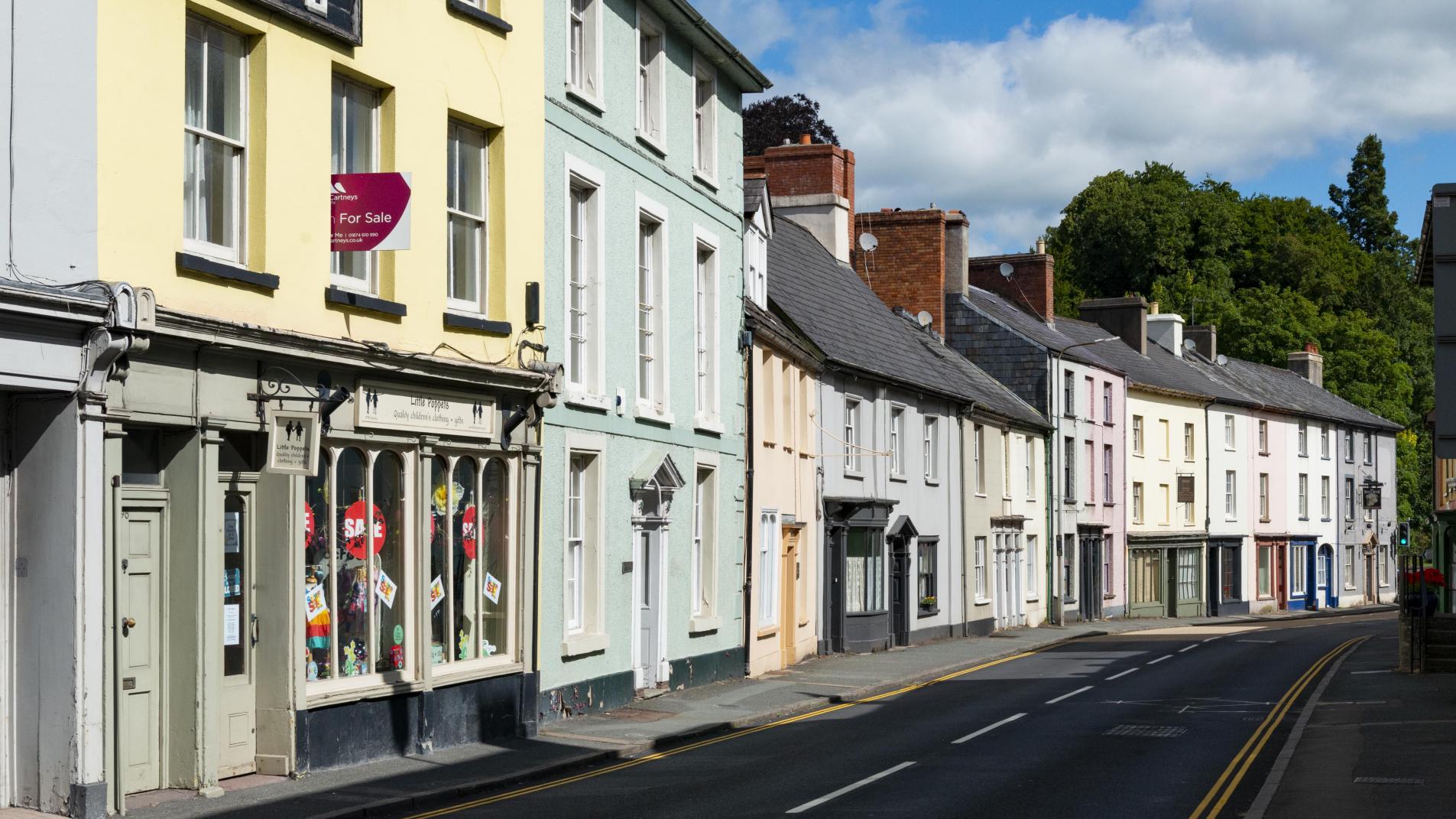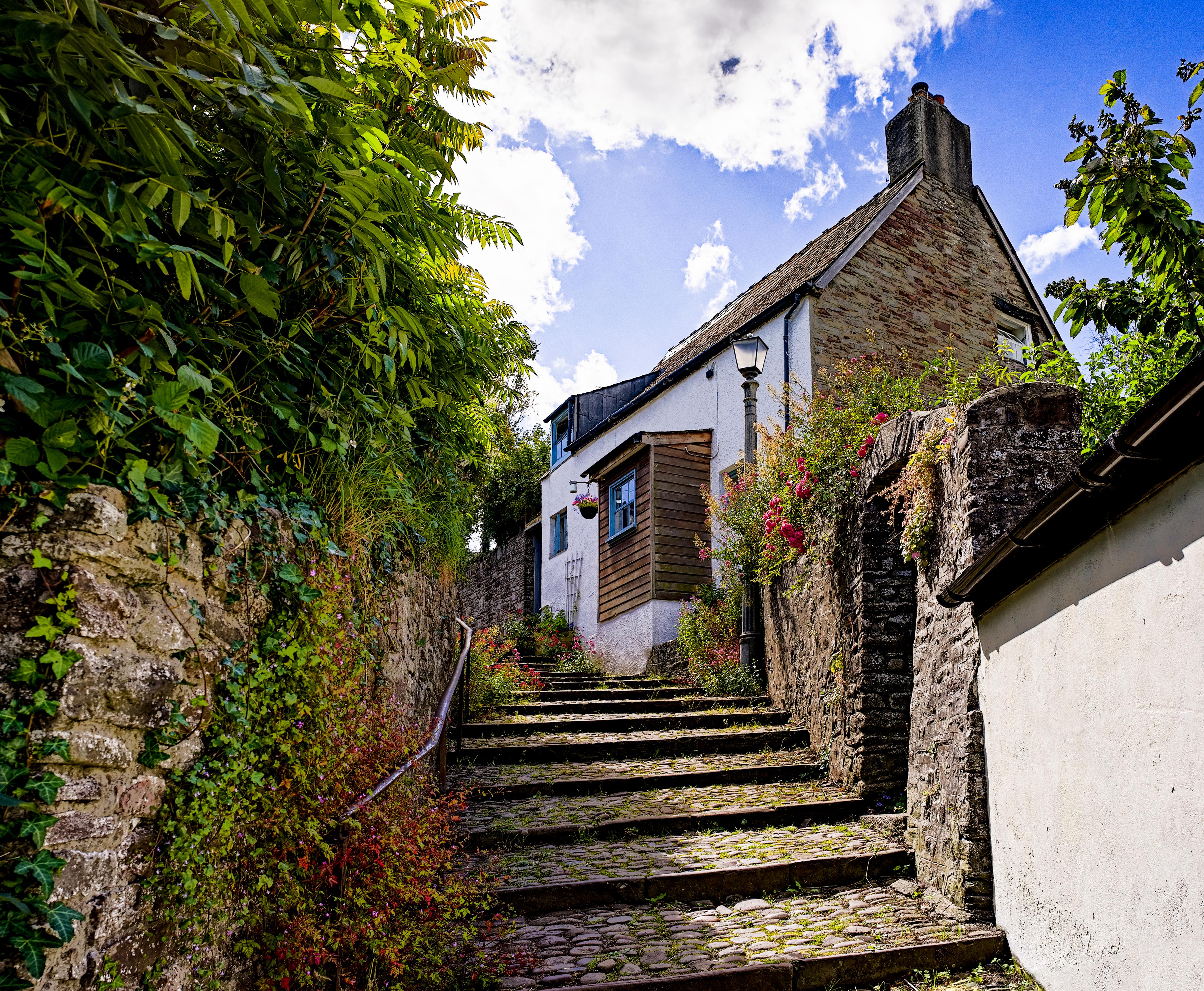
Visit historic buildings along High Street Superior & The Struet. This is the 5th stop in WALK: The Brecon Story, our heritage trail around Brecon.
High Street Superior
At the top of Lion Street we pass 19-20 High Street - birthplace of Frances Hoggan (1843-1927), the first British woman to receive a degree in medicine. She had to travel to Zurich to graduate in 1870 - becoming only the second woman in Europe to become a doctor of medicine. She specialised in diseases of women and children and became a pioneering social reformer, campaigning for Welsh Girls to have access to a secondary education.
Across the road an archway into Bell Lane shelters a sign reading ‘LICENSED TO LET POST HORSES.’ This was the entrance to the stables of another celebrated Brecon coaching business, the Bell Inn and Camden Arms Hotel. It was also owned by Thomas Longfellow, the entrepreneur celebrated in the description of the Golden Lion Hotel that we have read about on the plaque in Bethel Square. Actors staged shows here for eight weeks from May-July in 1755 with other shows continuing till at least 1789 according to the oldest surviving example of a Brecon Theatre playbill. Another ancient flyer for the Bell Inn boasts: ‘Coaches to all parts of the Kingdom daily (Sundays exempted) at 7 in the morning to London in 23 hours through Cheltenham, Bristol, Bath and Marlborough.’ It also portrays this building.
A few doors up from our ancient archway lies another arch of younger and grander design. The Market Hall was built on the site of the Queen’s Head Inn following an act of parliament passed in 1838. The original estimate to build it was £2,280 but the final bill came to £4,500. It was a response to complaints about dirt and smell in the market under the Guildhall that we visited at the start of this tour. But it has become home to so much more. Many lifelong Breconians will tell you of bands they’ve seen play here in their youth. In more recent times, Brecon Jazz, launched in 1984, has brought stars such as Joan Armatrading, Burt Bacharach, Cleo Lane and Johnny Danworth, George Melly, Van Morrison, Amy Winehouse and Jools Holland. Indeed, the festival put the town on the international music map, drawing in some 50,000 visitors a year.
The Struet
Heading out of town, we cross the traffic lights and arrive in The Struet and a street of more Georgian and Victorian elegance if you look beyond some of the fading paint. The origin of the name is uncertain, some suggesting ystrwaid or [fish] trap - that may have sat in the river behind the street or that it was a place of craftsmen.
On the left the RAFA club was once the Angel Hotel with its roots in the 18th century with the County House or Judges’ Lodgings next door. In 1859 a job was offered to run the building for £20 a year. By 1918 the ‘Cook-General’ to the house would be offered £22 a year. In 1933, the visiting Judge of Assize, Mr Justice Goddard complained about an inadequate kitchen, an unfit lavatory, an uncomfortable bed and insisted that “the lodging should be greatly improved”. The judge went on to be Lord Chief Justice of England and Wales and presided over the infamous Derek Bentley case after which a man was wrongly hanged.
Next door you can just about read the words ‘Viaduct House’ painted above the first floor windows. This refers to the railway viaduct which once ran across the street and over the river behind it, before heading down to Neath. Beyond, Boughrood House was once a school to “instruct poor children...of Brecon, in the English language, the better to enable them to serve God and manage their respective trades and occupations.’ The school was funded by a trust set up in 1686 by the Rev Rees Powell of Boughrood and flourished until it was amalgamated with the National School in Pendre in 1855 - with a ‘Ladies School’ operating here in the 1880s.
Across the road stands a grade II listed telephone box, of a design introduced in 1936. It is next door to 10 The Struet, built in the late 18th century by Hugh Bold, Attorney and once joined with number 9 (Plaque 16). It has been a house, entertainment rooms for the town, a school, local government offices, a rugby club and then a hostel and holiday accommodation before a beautiful restoration in recent years. Further along, Hamilton House echoes some of the beauty with its grand early 19th century exterior hiding a very fine Regency interior. Beyond is the former Star Inn. In 1840, an inquest was held here after a local man ‘of intemperate habits’ died in the street with ‘violent bleeding in the mouth. The verdict: ‘Died by visitation of God’. In 1841, a newspaper reported that: ‘A lodge of Ivorites of the fair sex was opened…at the Star Inn.’ The True Ivorites were the only friendly society to conduct their business exclusively in Welsh and helped the poor and needy as well as organising local eisteddfodau.
Staying with pubs, the Bull’s Head Inn, opposite, has a few tales to tell. Inquests, held here in the 19th century hint at some of the poverty and deprivation of the time. One concerned the death of a five year old with scrofura and rickets, another, the two year old son of hawkers who fell into the river and drowned. A third, from 1898 noted how the 10 month old baby of ‘drunken’ parents had died of bronchitis in a house where there was no food but a lump of salt.
The double fronted Huntington House reminds us that the building once housed a Calvanistic Methodist Chapel paid for by the Countess of Huntington. Alongside rise the King Charles Steps, or King Street, remembering King Charles I who visited Brecon during the Civil War. There may be few houses along its steep rise now but newspaper accounts suggest a busy concentration of homes in the 19th and early 20th century. Reports refer to a child who drowned in a local pond, the son of an engine driver missing in action in World War One and a 15 year old charged, in 1902, with ‘larceny’ - trying to buy ‘a half pennorth of sweets’ with a counterfeit three pence coin. He was eventually discharged after pleading guilty, his father paying 20 shillings in costs.
The Struet is part of our WALK: The Brecon Story heritage trail. Click here to access the Google Earth map or visit the next place on our trail
